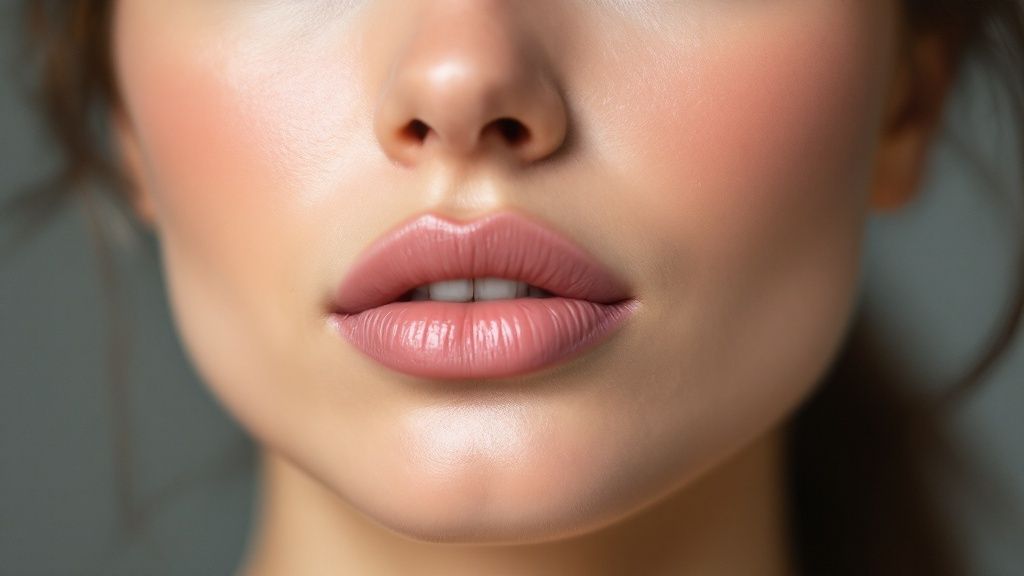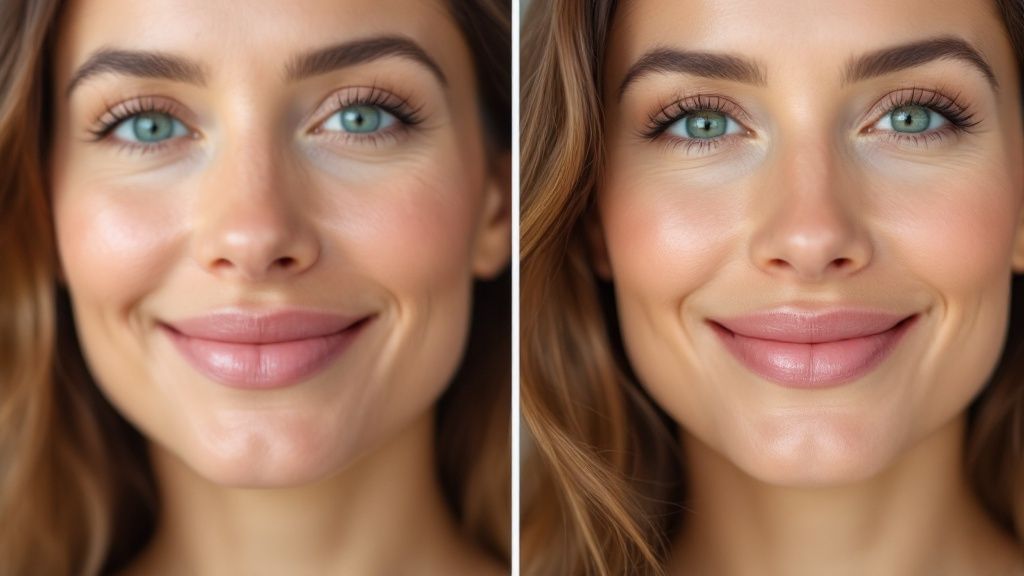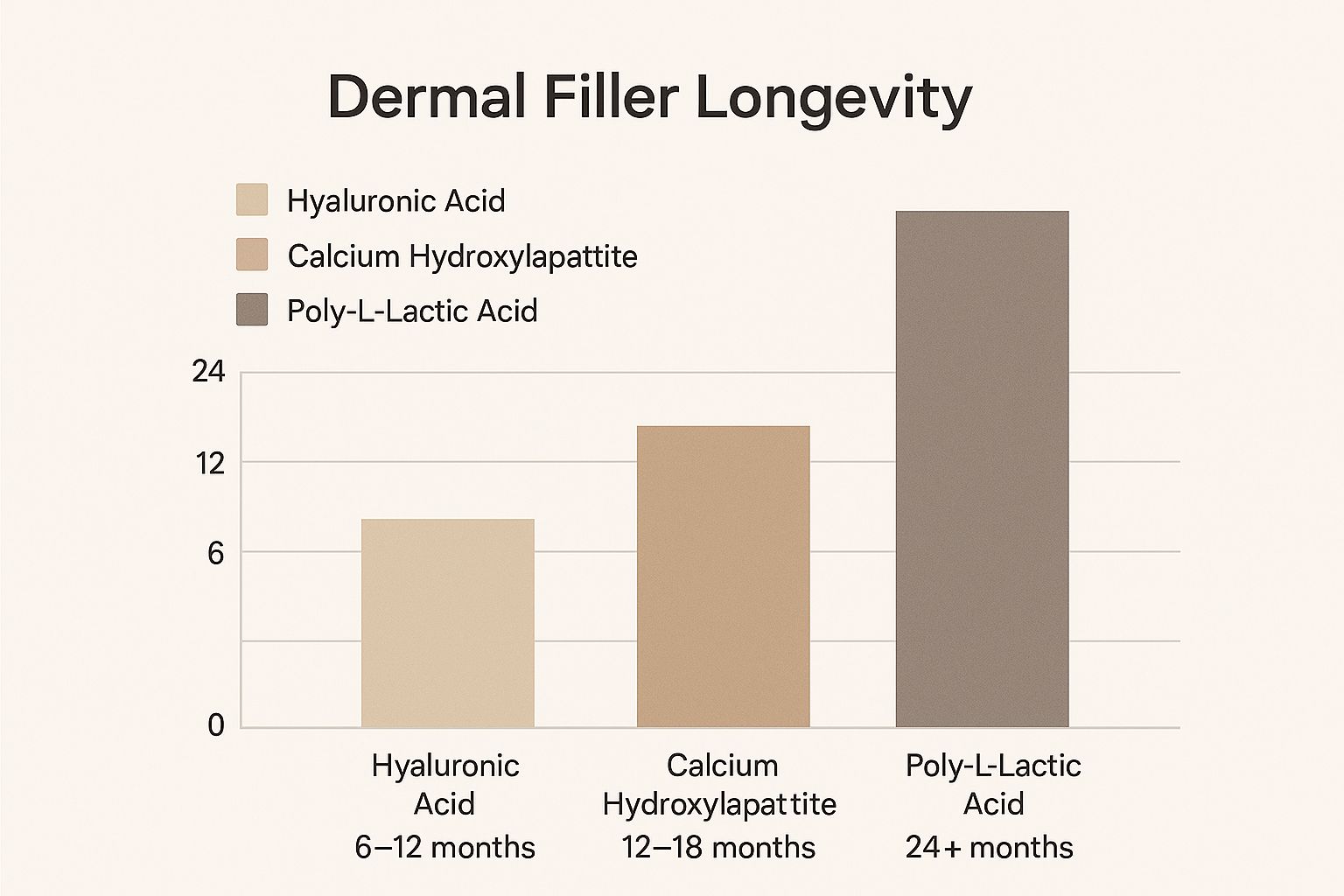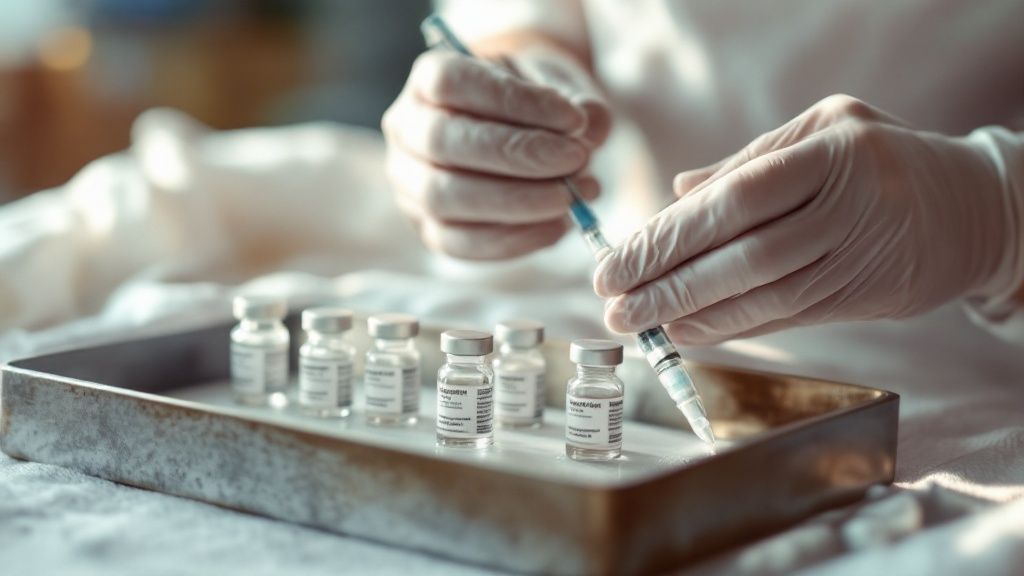
Dermal fillers are injectable gels that work wonders to restore volume, smooth away wrinkles, and sharpen facial features, leaving you with a refreshed, totally natural look.
It's helpful to think of them not just as "filling" lines, but as rebuilding your skin's deep support structure. Imagine plumping up a cushion that's lost its fluff over time—that’s what fillers do for your skin from the inside out. Their main job is to tackle age-related volume loss and gently refine your facial contours.
Rebuilding Your Skin From Within
Dermal fillers are one of the most versatile tools we have in aesthetics. They offer a powerful non-surgical solution for rejuvenating and bringing harmony back to your facial features. Unlike treatments that relax muscles to smooth wrinkles, fillers work by physically adding volume right where it's needed beneath the skin. This hands-on approach allows a skilled injector to address a huge range of cosmetic concerns with incredible precision.
The applications are incredibly broad, covering everything from the most subtle tweaks to providing more significant structural support.
Some of the most common uses include:
- Restoring Youthful Fullness: Re-plumping areas like the cheeks that can start to look hollow or flat as we age.
- Smoothing Deep Lines: Softening those prominent wrinkles, like nasolabial folds (the "smile lines" around your mouth) and marionette lines.
- Enhancing Facial Contours: Defining a soft or weak jawline, augmenting the chin for better projection, or even subtly reshaping the nose.
- Adding Volume to Lips: Creating a fuller, more defined pout or smoothing out those fine vertical lip lines.
At its core, the goal is always to restore balance. We want to provide a natural-looking lift that gracefully counters the effects of time, giving you a result that's immediate yet beautifully understated.
To get a clearer picture of how different fillers are used for specific goals, you can explore the details in our dedicated dermal filler services. Ultimately, these treatments are all about rebuilding your skin's foundation for a smoother, more vibrant appearance.

Here's a quick look at how fillers are commonly used to achieve specific aesthetic results.
Primary Uses of Dermal Fillers at a Glance
| Primary Use | Aesthetic Goal | Common Treatment Areas |
|---|---|---|
| Volume Restoration | Restore youthful fullness and lift | Cheeks, temples, under-eyes |
| Wrinkle Smoothing | Soften deep folds and creases | Nasolabial folds, marionette lines |
| Contouring & Definition | Enhance facial structure and balance | Jawline, chin, nose |
| Lip Enhancement | Add volume, shape, and definition | Lips, vertical lip lines |
This table shows just how adaptable these treatments are, making them a go-to for creating customized, natural-looking enhancements.
How Dermal Fillers Bring Back Your Skin's Volume

So, what are dermal fillers really doing under your skin? Think of them as sophisticated gels designed to rebuild your skin’s inner scaffolding—the support system that keeps everything looking firm and youthful.
The most common and trusted type of filler is made with Hyaluronic Acid (HA), a sugar molecule your body already produces naturally to keep your skin hydrated and plump.
You can think of HA as your skin's built-in moisturizer. Each tiny molecule acts like a sponge, drawing in and holding up to 1,000 times its weight in water. This is the secret behind that dewy, full look we associate with young skin. But as we get older, our natural HA supply dwindles, which leads to volume loss, sagging, and wrinkles.
The Science of Rejuvenation
When an HA filler is carefully placed by an expert, it immediately gets to work. The gel provides instant physical support, lifting sagging areas and smoothing out lines from within. At the same time, it starts attracting water to the area, which boosts volume even more for a soft, natural-looking fullness.
It’s a two-part process that delivers beautiful results:
- Immediate Lift: The gel acts as a physical cushion, propping up the skin right away.
- Deep Hydration: The HA molecules pull in moisture, plumping the area from the inside out.
The real magic of HA fillers is that your body already recognizes hyaluronic acid. Since it’s a substance found naturally in your skin, the risk of an adverse reaction is incredibly low. This makes it a safe, reliable, and predictable choice for aesthetic treatments.
While HA is the gold standard for many, other types of fillers work by encouraging your body to produce its own collagen for longer-lasting structural improvement. Having different tools like these allows a skilled injector to tailor the treatment perfectly to your unique facial anatomy and goals. For a deeper dive into the mechanics, you can learn more about how dermal fillers work in our comprehensive guide.
It's no surprise that these treatments have become so popular. The aesthetics market for HA-based fillers was valued at around USD 5.27 billion in 2025 and continues to grow—a clear sign of their effectiveness and trusted safety profile.
Exploring the Most Popular Treatment Areas
Now that we understand the "how" behind dermal fillers, let's get into the "where." Think of fillers as an artist's tool for subtle facial sculpting. They aren't about changing who you are, but rather restoring balance, structure, and that youthful softness that time can diminish.
Every area of the face requires a completely different approach. This isn’t a one-size-fits-all treatment; it's a highly customized plan based on your unique anatomy.
Cheeks and Midface Restoration
One of the first places we notice age-related volume loss is in the cheeks. The supportive fat pads in the midface can shrink and drift downwards, leading to a flatter, more tired appearance. This is where fillers work beautifully.
By strategically placing a firmer, more supportive filler along the cheekbone, an experienced injector can rebuild that gentle, youthful curve. This does more than just restore the cheeks—it creates a subtle lift for the entire lower face, softening smile lines and bringing back a sense of harmony. The goal is always a soft, natural contour, not a puffy or overdone look.
Lips and Perioral Rejuvenation
Lip enhancement is easily one of the most requested filler treatments, but it’s about so much more than just adding size. A skilled practitioner uses filler to define the lip border (the vermillion border), correct any asymmetries, and smooth out those pesky vertical lines that can appear around the mouth.
Using a soft, flexible filler to hydrate the body of the lips can give them a smooth, beautifully defined, and naturally full appearance. It's a treatment that can be tailored for anything from a barely-there refresh to more noticeable volume.
The secret to stunning results lies in respecting your natural anatomy. A great injector enhances what you already have, ensuring the outcome looks and feels completely authentic to you.
Smoothing Smile Lines and Marionette Lines
We all have them. Nasolabial folds, or "smile lines," run from the sides of the nose down to the corners of the mouth. Marionette lines are the ones that extend downwards from the corners of your mouth, sometimes creating a sad or downturned expression.
Both of these common concerns are perfect candidates for filler. By carefully placing filler directly into these creases, we can lift and soften them, creating a smoother and instantly more refreshed appearance. If this is a specific area of concern for you, we break down all the options in our guide on the best filler for smile lines.
The infographic below gives you a clear idea of how long you can expect different types of dermal fillers to last.

As you can see, while popular Hyaluronic Acid fillers offer temporary and reversible results, other types like Poly-L-Lactic Acid can provide much longer-lasting improvement by encouraging your own body to produce more collagen.
Dermal Filler Treatment Areas and Expected Outcomes
To make it even clearer, here’s a quick breakdown of common treatment zones, the concerns they address, and what you can realistically expect from a filler treatment.
| Treatment Area | Common Concern | Typical Filler Type | Expected Outcome |
|---|---|---|---|
| Cheeks | Flatness, sagging, volume loss | Hyaluronic Acid (e.g., Juvéderm Voluma) | Lifted midface, restored youthful curve, softened nasolabial folds |
| Lips | Thinness, asymmetry, fine lines | Hyaluronic Acid (e.g., Juvéderm Ultra, Restylane Kysse) | Enhanced volume, improved definition, smoother texture, hydration |
| Under Eyes | Hollows, dark circles, tired look | Hyaluronic Acid (e.g., Restylane-L, Belotero Balance) | Smoothed transition from eye to cheek, reduced shadowing |
| Jawline & Chin | Lack of definition, jowls, weak chin | Hyaluronic Acid (e.g., Juvéderm Volux), CaHA | Sharper, more defined jawline; balanced facial profile |
| Smile Lines | Deep nasolabial folds | Hyaluronic Acid (e.g., Juvéderm Vollure, Restylane Defyne) | Softened creases, smoother and more refreshed appearance |
| Temples | Hollowness, "peanut head" shape | Hyaluronic Acid (e.g., Juvéderm Voluma), PLLA | Restored volume, balanced facial proportions, subtle brow lift |
This table illustrates just how versatile fillers are. A skilled injector can use them not just to fill lines, but to strategically rebalance and rejuvenate the entire facial structure for a harmonious, natural result.
Advanced Uses Beyond Smoothing Wrinkles

When most people think of dermal fillers, they picture erasing a few fine lines. But that’s just scratching the surface. In the hands of a skilled injector, fillers become sophisticated sculpting tools, subtly redefining contours and enhancing your entire facial harmony.
We're moving beyond just filling a single wrinkle. The modern approach is about strategically rebuilding the underlying support where age has taken its toll. It's less about adding volume and more about restoring balance.
Redefining Facial Structure
This is what fillers are truly for in today’s world—creating definition and proportion. An experienced practitioner can use them for incredible structural enhancements, often with no surgery required.
- Non-Surgical Nose Reshaping: A few precise injections can smooth a bump on the bridge of your nose or lift a drooping tip. It's a game-changer for refining your profile without going under the knife.
- Jawline Contouring: By carefully adding filler along the mandible, an injector can sculpt a sharper, more chiseled jawline. This beautifully frames the face and can even minimize the look of jowls.
- Hand Rejuvenation: Fillers aren't just for the face. They can restore lost volume on the back of the hands, making prominent veins and tendons far less noticeable for a smoother, more youthful appearance.
This approach is all about holistic facial harmonization. It’s not just chasing a single line but looking at the big picture to create a result that is balanced, refreshed, and completely natural-looking.
These advanced techniques are a huge part of why consumers are increasingly seeking out effective, minimally invasive procedures. It's a major driver behind the growth of the aesthetic industry—the global dermal fillers market was valued at around USD 6.6 billion in 2025 and is expected to hit USD 9.0 billion by 2035. You can find more details on this trend over at Future Market Insights.
How to Support and Extend Your Results at Home
Your beautiful results don't stop when you leave the clinic. Smart at-home care is the secret to protecting your investment, helping your fillers last longer, and keeping your skin in peak condition.
Think of professional treatments as the heavy lifting. Your daily routine is what maintains that strength. While a consistent skincare regimen is your foundation, adding advanced tools can elevate your results from good to incredible. Our top recommendation? A high-quality, at-home light therapy device.
Amplify Your Results with Advanced Skincare Tech
We designed the Barb N.P. LED Facial Mask as the perfect partner for your filler treatments. Its wireless design and comfortable, easy-to-wear fit mean you’ll actually use it consistently—and consistency is everything. The mask uses three targeted light settings that work together to support your skin's health post-procedure.
Here’s how each light helps:
- Red Light: This is your collagen booster. It works deep within the skin to stimulate firmness and maintain the structural support your fillers provide.
- Blue Light: Think of this as your clarifying light. It targets blemish-causing bacteria, promoting a smoother, clearer complexion.
- Yellow Light: This is the perfect post-treatment setting. It calms redness and soothes inflammation, helping your skin recover beautifully and quickly.
To get the most out of every session, pair the mask with a powerful serum. Applying the Barb N.P. Hyaluronic Acid Serum right before you put on the mask creates a super-hydrating environment. This locks in moisture at the surface, leaving your skin looking plump, radiant, and incredibly refreshed.
This combination of professional fillers and dedicated at-home care is the ultimate strategy for rejuvenation. It helps you fully understand what dermal fillers are used for—not just filling lines, but kickstarting a journey toward healthier, more resilient skin for the long haul.
Common Questions About Dermal Fillers
Stepping into the world of aesthetic treatments always comes with a few questions. From how long the results last to what the experience feels like, getting the right information is the key to feeling confident and excited about your decision. Let’s walk through some of the most common queries I hear from my clients.
One of the first things everyone wants to know is, "How long will this last?" The longevity of dermal fillers isn't a one-size-fits-all answer—it depends on the type of filler used, where it’s placed, and even your own body's metabolism. Generally speaking, you can expect hyaluronic acid fillers to last anywhere from 6 to 18 months.
Fillers in high-movement areas of the face, like your lips, tend to break down a bit faster than those in more stable areas, like the cheeks.
Your Comfort and Safety
Concerns about comfort are completely understandable, but most people are pleasantly surprised. Patients usually report just minor, temporary discomfort during the injection process. To make the experience as comfortable as possible, many of the best modern fillers are pre-mixed with lidocaine, a local anesthetic. On top of that, your practitioner will almost always apply a topical numbing cream to the area beforehand.
Your safety and results hinge on one thing above all else: the expertise of your injector. Always, always choose a licensed and experienced medical professional, like a board-certified dermatologist or a licensed nurse practitioner. This is your best insurance for beautiful, natural-looking results while minimizing any risks.
This focus on safety and professional care is a huge reason why the aesthetics market keeps growing. In fact, North America is leading the way, holding a dominant market share of about 42.7% in 2024, fueled by social acceptance and a strong healthcare infrastructure. You can dive deeper into these market growth factors on marketsandmarkets.com.
Another frequent question is about downtime. Here’s the great news: dermal fillers are famous for requiring very little recovery. You might see some temporary swelling, redness, or bruising at the injection site, but these effects typically fade within a few days. Most people can jump right back into their normal routine.
And if you're wondering how fillers are different from other popular injectables, we have a complete guide breaking down dermal fillers vs. Botox.
To get the most out of your professional treatments and support your skin’s health at home, the right aftercare is key. The Barb N.P. LED Facial Mask is an incredible tool for this. It's wireless, fits comfortably, and has three light settings for targeted care—red light to boost collagen, blue to improve clarity, and yellow to soothe any post-procedure redness.
Explore the Barb N.P. LED Facial Mask and other medical-grade skincare at BotoxBarb.

